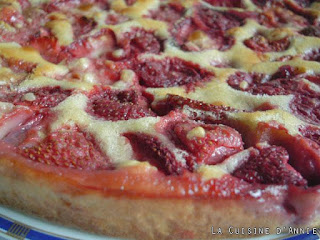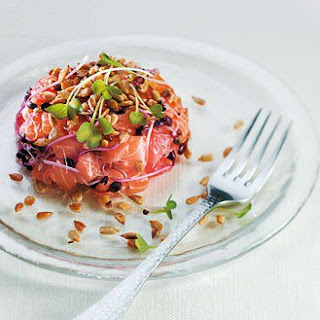A Cherry Clafoutis
www.flickr.com/photos/ipalatin/7326966018/
Clafoutis began as tarts made with a thick crêpe-like batter cooked together with sour cherries. They became so popular outside the old region of Limousin where they originated that when cherries were not in season chefs added other fresh fruits. Following on that success, the Clafoutis expanded their territory. Now we have breakfast Clafoutis with button mushrooms and tomatoes, light lunch Clafoutis with salmon or cheese and the main course at lunch or dinner may include a vegetable Clafoutis offered as a garnish. Oh, and you can still have a Clafoutis with cherries or other fruits as a dessert. (The old region of Limousin included the departments of Corrèz, Creuse, and
Haute-Vienne).
On 1-1-2016 the administrative region of Limousin was joined together with the regions of Aquitaine, and Poitou-Charentes in the new super-region of Nouvelle Aquitaine. The old regions' names will remain linked to the foods and wines that are named after them, but their borders will disappear from most maps.
On 1-1-2016 the administrative region of Limousin was joined together with the regions of Aquitaine, and Poitou-Charentes in the new super-region of Nouvelle Aquitaine. The old regions' names will remain linked to the foods and wines that are named after them, but their borders will disappear from most maps.
N.B. The word Clafoutis is pronounced kla-fou-tee, the “s” is silent, and it’s the same word whether you order one or ten Clafoutis.
A Peach
Clafoutis
www.flickr.com/photos/citron-vert/4803650883/
Depending on the ingredients Clafoutis may be served hot, warm, or cold. For a single diner, a Clafoutis will usually be made in a single serving dish with a large Clafoutis also being seen when a whole table or a number of patrons make the same order. Some travel guides refer to a Clafoutis as a flan or pie. However, since the French own the product; and they call Clafoutis a tarte, they are a tart in English.
Clafoutis on French menus:
Clafoutis au Reblochon de Savoie et aux Quetsches - A Clafoutis prepared with quetsche plums and France’s Reblochon AOP cow’s milk cheese from the Savoie. The quetsche plum is a mauve to almost black plum that has a fragrant and sweet yellow flesh; it is oval shaped with nearly pointed ends. The quetsche’s nearest UK relation is the damson plum which is not as sweet.
Clafoutis aux Abricots – A Clafoutis with apricots;
Clafoutis aux Griottes– A Clafoutis with France’s griottes, sour cherries; the original recipe.
A black
raspberry clafoutis with ice-cream.
(Black raspberries are a North American rasberry family member)
www.flickr.com/photos/stuart_spivack/14591610822
Clafoutis aux Pommes, Servi Tiède et Glace au Calvados – A Clafoutis made with apples and served warm with ice cream flavored with Calvados. Calvados and there are three distinct types, is Normandy’s famous Calvados AOC Apple brandy.
Clafoutis de Saumon Salade Mêlée - A Clafoutis made with salmon and served with a mixed salad. Salmon in France is the Atlantic salmon.
A
Clafoutis with plums and almonds
www.flickr.com/photos/12699042@N00/7984229072/
Clafoutis de Chèvre et Olives et sa Frisée aux Petits Lardons – A Clafoutis served with a warmed goat’s cheese and olives accompanied by a small salad made with the crispy curly endive flavored with small bacon pieces. The Frisée or Chicorée or Endive Frisée is the curly endive. It looks like a lettuce with outer green leaves that curl and in a salad, it adds a slight crunch with a pleasant but slightly bitter taste. The lighter-colored inner leaves are milder and are considered the best for salads.
Now that Clafoutis are on menus for breakfast, lunch, and dinner that creates problems with Limousine’s other famous tart, the flangnarde also called the flognarde or flaugnarde. (The name used depends on tradition, and are pronounced with the letter g silent, so flaugnarde is pronounced flo-nyard).
In the Occitan language, the word Flaugnards is said to come from the word fleunhe meaning soft, and that will describe the texture of a Flaugnard and a Clafouti. (Occitan is the language that lost out to French when the country looked for a single unifying language).
Flaugnardes and Flognardes on French menus:
Flaugnarde Pomme-Poire à la Fève Tonka – A Flaugnard with apples and pears flavored with the Tonka bean. The Tonka bean is a plant of South American origins with a strong aroma and used as a spice. I have never had the opportunity to smell or taste the Tonka bean on its own but the aroma is said to resemble vanilla with a touch of almonds and cinnamon and it is mostly used in aniseed-flavored drinks like pastis.
Apricot
Flaugnarde
Flaugnarde de Nèfles aux Pommes – A Flaugnarde with loquats and apples. When cooked apples are on the menu it is nearly always Granny Smith’s.
Grape
Flaugnade.
Flognarde aux Mirabelles – A Flognarde made with the Mirabelle plum; a small, yellow to reddish plum that is France’s favorite plum for confitures, jams, and conserves. The Mirabelle developed locally in the old region of the Lorraine in Northern France most probably from trees that were imported by the Romans, who imported cherries, apricots, and peaches, or it may have been other traders. The origins of the plum are to the north-east of modern Turkey and the adjacent Caucasus,
Still, the world center for the modern Mirabelle is the Lorraine and while not everyone has heard of the Mirabelle plum or even the Lorraine everyone has heard of the Quiche Lorraine. Since 1-1-2016 the region of Lorraine together with the regions of Alsace, famous for its cuisine and wines, and the Champagne-Ardenne, famous for Champagne, have become parts of the new French super-region of the Grande Est, the Great East.
Limousin will, however, remain on the culinary map of France. As you drive around the Limousin breed of cattle is recognizable by their chestnut red coloring. Their name may not be on many menus, but nearly every restaurant offering steaks, roasts or daubs without an AOC/AOP, a Label Rouge or a named source will be offering Limousin beef.
Limousin
bull.
www.flickr.com/photos/simmysphotos/7436357324/
Restaurant cheese trays on Limousin will include French AOP cheeses as well as first-rate Limousin cheeses that only rarely make it to fromageries, cheese shops, outside the area. The best local cheeses include the Geuille du Limousin, the Leconet and Saint Pierre goat’s milk cheeses and the Gouzon and Millevaches cow’s milk cheeses.
All around the old region of Limousin are places where the weather, soil are high altitude are said to be especially good for apples. Here grown France’s only AOP apple the Pomme du Limousin AOC, the Golden Delicious apple of Limousin. Like other regions with particular routes for wines or cheeses the Limousin has a Route de Pommes, an apple road, You can take that and enjoy apples and cider along with cheeses and stop off for lunch or dinner at restaurants offering Limousin Beef. All local Tourist Information Offices offer directions.
For something other than culinary enjoyment in Limousin visit the City of Limoges, This is capital the capital of the department of Haute-Vienne and the home of Limoges porcelain The Museum Adrien Dubouché with its unique porcelain collection has an English language website:
For something other than culinary enjoyment in Limousin visit the City of Limoges, This is capital the capital of the department of Haute-Vienne and the home of Limoges porcelain The Museum Adrien Dubouché with its unique porcelain collection has an English language website:
Then visit the small town of Aubusson in the department of Creuze so famous for the Aubusson tapestry. The Departmental Museum of Tapestry has an astonishing collection but their website is in French only but easily understood using the Google or Bing Translate apps:
A place
to sit down and rest in the Tapestry Museum Aubusson
--------------------------------
Behind the French Menu
by
Bryan G. Newman
behindthefrenchmenu@gmail.com
Copyright 2010, 2013, 2018, 2019
--------------------------------
Searching for the meaning of words, names or phrases
on
French menus?
you are searching for to the words
"Behind the French Menu" (best when including the inverted commas),
and search with Google, Bing, or another browser. Behind the French
Menu’s links, include hundreds of words, names, and phrases that are seen on
French menus. There are over 450 articles that include over 4,000 French dishes
with English translations and explanations.
Connected Posts:
Tomate – Tomato. France’s Greatest Tomato, the Tomate de Marmande AOC. The Tomato in French Cuisine.






















